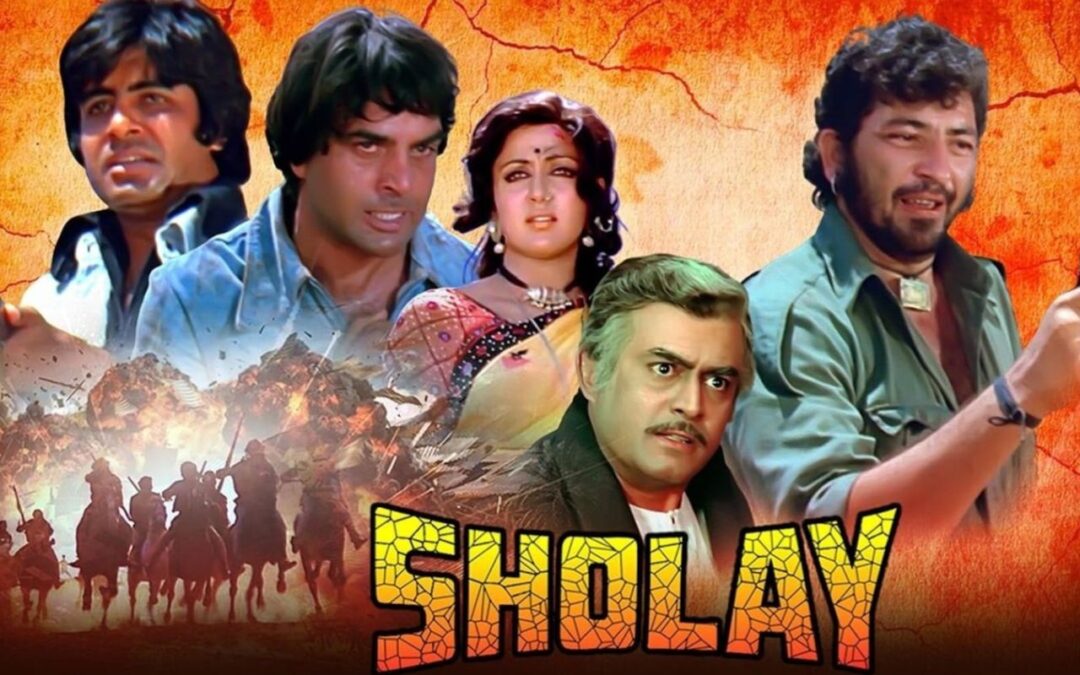When you think about a Bollywood movie with a perfect balance of comedy, action, drama, and unforgettable dialogues, one name that instantly pops up every time is Sholay, Bollywood’s most legendary film. Sholay shaped how entire generations think about heroism, revenge and friendship.
It’s been 50 years since Ramgarh exploded on screen and Gabbar is back to do it again. Yes, you heard it right! Sholay is coming back but as the original uncut version which was deleted in the previous releases. It is not just a nostalgic stunt, but an attempt to experience Ramesh Sippy’s full vision, just as he intended 50 years ago. Read on to find what’s new in Ramgarh’s destiny this time.
Re-release Details: When and Where?
India’s most-watched film Sholay, now named as Sholay: The Final Cut is set to hit theatres on 12 December 2025. The announcement was made by Film Heritage Foundation and Sippy Films. The film has been restored to 4K and will screen across 1500 screens with the original climax for the first time in decades.
Apart from the 4K screen, the soundtrack has also been restored with a cleaned-up Dolby-ready audio. This will be an authentic re-experience of a film that defined the excellence of Indian cinema years ago.
What exactly are we getting back?
Back when Sholay was released in 1975, the film’s original climax was trimmed due to censorship and distribution disputes. A few scenes and narratives were also altered to pass the censor board requirements.
There was a scene where Thakur kills Gabbar with his spiked shoes. The scene was considered extremely violent and was asked to tone down before the final release.
Over time, the talk of the uncut version became a myth and the new 4K restoration is coming back with that footage which was originally shot but the audience didn’t see at that time. That’s why the new release has been named The Final Cut.
Reports say that the print has been scanned and cleaned frame by frame, colour graded back to the original negatives and prepared for this re-release.
The Cast and The Filmmakers
Main Cast
- Amitabh Bachchan as Jai: the calm and shooting partner of Veeru.
- Dharmendra as Veeru: the lively, emotional heart of the film.
- Amjad Khan as Gabbar Singh: the leader of the bandits and the most iconic Bollywood villain of all time.
- Sanjeev Kumar as Thakur Baldev Singh: the fallen lawman seeking revenge and justice.
- Hema Malini as Basanti: Love of Veeru, talkative horse-cart driver.
- Jaya Bachchan as Radha: the silent widow, has a love connection with Jai but never speaks with him till the end
Supporting Cast
- Mac Mohan as Sambha: the right-hand man of Gabbar, popular with the iconic line “Arre O Sambha! Kitne aadmi the”
- Asrani as the unforgettable Angrezon ke zamaane ka jailer.
- Jagdeep as Soorma Bhopali.
- Viju Khote and Keshto Mukherjee in memorable supporting roles.
- A.K. Hangal as Imam Saab, offering emotional gravitas.
- Satyen Kappu as Ramlaal, Thakur’s loyal house help.
Filmmakers
- Director: Ramesh Sippy
- Writers: Salim–Javed
- Music Composer: R.D. Burman
- Lyricist: Anand Bakshi
- Cinematographer: Dwarka Divecha
- Editor: M.S. Shinde
- Production Banner: Sippy Films
- Restoration by: Film Heritage Foundation (for the 4K re-release)
Also Read: List of Indian Movies Shot in IMAX Format (Digital Media Remastering)
About the Movie
Sholay (1975) is an action-adventure drama. Thakur Baldev Singh, a retired Police Officer, seeks revenge and justice after the dacoit Gabbar killed his entire family. He hires Jai and Veeru who are fearless criminals and seeks bail from jail. The fictional story is set in the village of Ramgarh.
The film ran over 5 years and became one of the longest-running movies. Amjad Khan’s voice which was initially considered too weak became the most iconic voice of the villain. Basanti’s Horse became a pop culture phenomenon, and “Yeh Dosti” is still being used to show an unbreakable bond like Jai and Veeru.
The powerful team is the reason why Sholay still feels fresh even half a century later. For the ones who grew up with “Soja nhi to Gabbar aa jaaega,” the comeback of Gabbar feels like the old thrill coming back again. For the history of cinema, this re-release is a reminder that cinema is truly a living archive.
Written by Supriya

